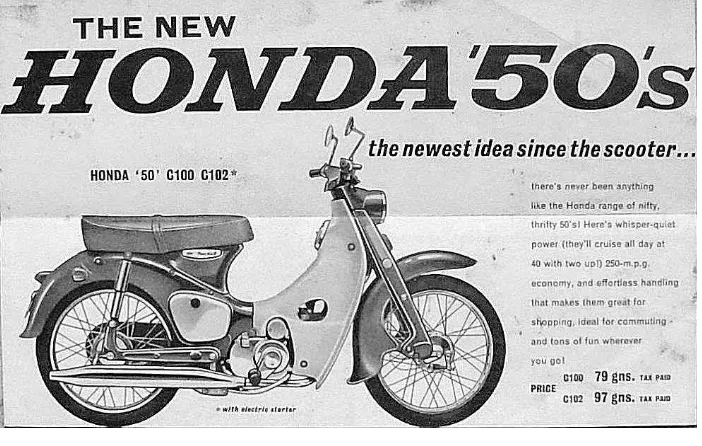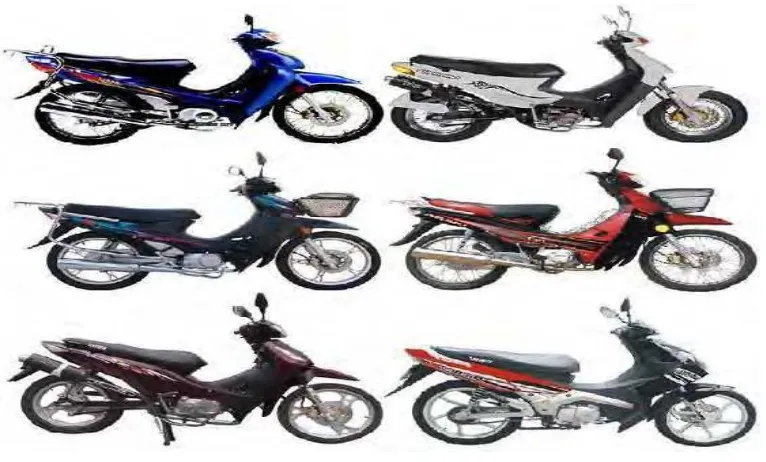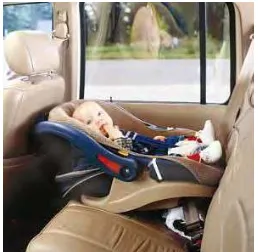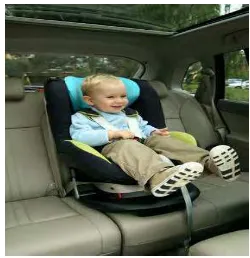i
DESIGN AND MODIFICATION FOR CHILD RESTRAINT SEAT ON MOPED MOTORCYCLE
HASFARIZAL BIN FARIZAD
A thesis submitted in fulfillment of the requirements for the award of the degree of
Engineering Technology
Faculty of Engineering Technology University of Technical Malaysia Malacca
ii
DECLARATION
I declare that this thesis entitled “Design and fabricate a child restraint system for underbone motorcycle” is the result of my own research except as cited in the references. The thesis has not been accepted for any degree and is not concurrently
submitted in candidature of any other degree.
Signature : ……..………..……….………
Name : …....…….………
Date : …....…….………
iii
iv
ACKNOWLEDGEMENT
First and foremost, I would like to express my heartfelt appreciation to my respectful supervisors, Hairul Effendy Ab Maulod for providing me with an opportunity to pursue my studies for this project of my degree at Universiti Teknikal Malaysia Melaka (UTeM).
I would like to extend my gratitude to my panel Mohd Kamal Bin Musa and Muhammad Syafik Bin Jumali. Also thank you to all my members especially who have provided me with valuable suggestions and recommendations. To all members, thank you for providing assistance at various occasions throughout my study. Their views and tips are useful indeed. Unfortunately, it is not possible to list all of their names in this limited space.
v
APPROVAL
This report is submitted to faculty of Engineering Technology of UTeM as a partial fulfilment of the requirements for the degree of Bachelor of Manufacturing Engineering Technology (Product Design). The member of supervisory is as follows:
vi
ABSTRACT
vii
ABSTRAK
ix
2.6 Car Beds 9
2.7 Combination Child Seat and Belt-Positioning Booster Seat 9
2.8 Universal Anchorage System (UAS) 12
2.9 Locking Clip 12
2.10 Tethering 13
2.11 Study Current Child Restraint System 13
2.12 Adapt Current Design to Underbone Motorcycle 16
2.13 Calculation 17
3.2 Product Planning and Identifying Customer Needs (initial survey) 31
x
3.11 3D Design 46
3.12 Simulation 49
3.13 Fabrication and Modification 52
3.14 Prototype 53
CHAPTER 4: RESULT AND DISCUSSION 54
4.0 Introduction 54
4.8 Product Setup and Modification 81
4.9 Manufacturing to Selling Cost 87
5.4 Problems Faced During Project 89
5.5 Suggestion for Future Work (Recommendation) 90
REFERENCES 91
xi
LIST OF TABLES
2.1 Mean height (cm), weight (kg) and prevalence of 21 undernutrition among the Bauri caste children, aged
2-6 years
2.2 Anthropometric failure among the Bauri children by age 22 and category
2.3 Data of human weight and height from 3 month to 6 years 23 old
2.4 Data of human weight and height 24
3.1 Customer Needs 34
3.2 Customer Requirement 35
3.3 Engineering characteristic 37
3.4 The Design Concept 42
xii
2.12 Restraint system for superbike 15
2.13 Current design that been adapt to underbone motorcycle 16 2.14 The basic drawing dimension for child restraint system 16 2.15 Position that related to centre of gravity due to the wheel 17
xiii 3.15 Using CAD software to topology optimization to create a weight 50 efficient structural layout
3.16 Process of the simulation using 3D model of moped (underbone) 51 motorcycle
3.17 Applying the material to the studied product 51 3.18 The Model of Moped (Underbone) Motorcycle 52 4.1 Pie Chart for Respondent Who Had a Child 55
4.2 Bar Graph for Age of Respondent Child 55
4.3 Pie Chart for Safety Consideration 56
4.4 Graph for Popular Type of Child Restraint System 57 4.5 Graph for Respondent That Want to Buy the Child Restraint 58 System for Moped Motorcycle
4.6 Graph for Demand Price for Child Restraint System For Moped 59 Motorcycle
4.7 3D Drawing Product with Assembly 60
4.8 3D Drawing Explode Product 60
4.9 3D Drawing Product with Assembly at The Moped Motorcycle 62
4.10 Simulation Setup for the Static Study 64
4.11 Simulation Setup Continue 65
4.12 The Flow of Force Applied 66
4.13 Showing the Stress Effect on Product 67
4.14 Flow of Stress at the Child Restraint System 68
4.15 Stress Graph 69
4.16 Showing the Displacement Effect on Product 69 4.17 Flow of Displacement at The Child Restraint System 70
4.18 Displacement Graph 71
xiv
4.20 Strain Graph 73
4.21 The considering the size of the manikin in CATIA V6 74
4.22 Observed Manikin from Right 74
4.23 Manikin RULA ANALYSIS from Right 75
4.24 Observed Manikin from Left 76
4.25 Manikin RULA ANALYSIS from Left 76
4.26 Shows the posture editor from the left 77 4.27 Shows the posture editor from the right 77 4.28 Shows the correct posture from the left 78 4.29 Shows the correct posture from the right 79 4.30 Shows the correct posture for user using the product from 79
4.35 Attached the Cushion and BELT 84
4.36 Tighten the Under Clip and Locking the Chain Together 85
xv
LIST OF ABBREVIATIONS, SYMBOL AND
NOMENCLATURE
in - Inches
CAD - Computer Aided Design
SLD - System Level Design
CG - Centre of Gravity
AAP - American Academy of Pediatrics
V6 - Version 6
UAS - Universal Anchorage System
1
CHAPTER 1
INTRODUCTION
1.0 Introduction
In developing countries including Malaysia, motorcycles are cheap and affordable mode of transportation. It is not common to see, the motorcycles being used for almost all daily activities. For lower income groups a motorcycle could be considered a lifeline and important tool for daily life. Sadly though this also one of the attributes that safety of riding and pillion rider does not take utmost precedent. (Sivasankar, K. Karmegam, M.T. Shamsul Bahri, H. Sadeghi Naeini, & S. Kulanthayan, 2014).
1.1 Project Background
2
1.2 Problem Statement
Children when riding requires special attention since their anatomy are different than adult. Often in motorcycle-related accidents, children usually sustain lower limb injuries, which could temporarily or permanently inhibit the child’s movements. Furthermore often during the ride, children are easily tired and could doze off. Special requirements are needed to ensure their safety and comfort during pillion riding.
1.3 Objectives
The objective of the project is to;
a) To study the existing child seat restraint.
b) To design modification of child seat restraint to suit moped motorcycle placement.
c) To attach the modified child seat restraint on a moped motorcycle.
1.4 Project Scope
The project scope of the project is for the;
Study current system of underbone motorcycle carry a child. Adapt current system for underbone motorcycle.
3
CHAPTER 2
LITERATURE REVIEW
2.0 Introduction
This chapter will discuss mainly on the theory and current development in moped (underbone) motorcycle and child restraint system in transportation. This chapter will shows about the studied, product and the current research that had been found in developing child restraint system in transportation.
2.1 Moped Motorcycle
Figure 0.1: The new model Honda C50 moped
4
Figure 2.2: Variety of moped motorcycle
Based on the figure, there are variety of moped motorcycle that were currently in market. Some of it are being manufactured to Malaysia. The moped motorcycle are been used in Malaysia due to their affordable price and ease of use. More often we can see a young or child pillion rider clinging on to an adult at the front of the motorcycle in Malaysia. By the study, the main issues facing for the young pillion riders is that their safety is often not taken into account when they are riding on a motorcycle (Sivasankar, K. Karmegam, M.T. Shamsul Bahri, H. Sadeghi Naeini, & S. Kulanthayan, 2014).
5
2.2 Restraint System
The restraint system is about the ergonomic features that had in the car seat for child is to supports the occupant’s body under all driving conditions, offers adequate protection and body support in the event of an accident, allows for extended sitting without fatigue by relieving stress on the body’s muscular system, provides a contour matched to the vehicle and the occupant (sports seat, comfort seat) without restricting movement and we can also founded that back pain is the most common reason for visiting the doctor, accounting for almost 50 million sick days annually in Germany. Those most affected are people engaged in repetitive physical activities, especially frequent drivers (Pediatrics, 1998).
In addition, driving for hours in a forced posture without any compensatory movement is harmful to the back. Ergonomically incorrect sitting postures (such as “swayback”) further exacerbate the negative effects. This quickly leads to abrasion of the spinal disc and to back problems.
6
2.3 Types of Child Safety Seats
2.3.1 Convertible Safety Seat
The convertible child safety seat can be used in both the rear facing and forward facing positions. This type of seats must remain rear facing until our child is 2 years old or until he reaches the highest weight or height allowed by the manufacturer of his convertible safety seat (Guo SS, 1996). In this study, the idea must be modified to create the product that is suitable for child to seat at the motorcycle. Based on the convertible safety seat, the design of this product is related for the use of the average child at the age of 2 until 6 years old that is suitable for most child that been carried using the underbone motorcycle.
In addition, we can switch a convertible safety seat from the rear facing to the forward facing position, it can be used for a toddler up to 40 to 65 pounds (some seats accommodate up to 80 pounds) depending on the seat model (Guo SS, 1996)
2.3.2 Types of Child Safety Seats
There are three types of child safety seats for babies: Infant only Child Safety Seats
7
2.3.3 Infant-only Child Safety Seats
Infant-only safety seats are unique in that they are usually rear facing and come with a three or a five point harness. The most common type of harness is a five point, with two straps that secure the shoulders and two more that secure the hips. The straps all connect to a buckle between the legs. A less common type is a three point harness, which functions the same way but lacks the points at the hips.
Portable with a carrying handle; they can be easily removed and used as infant carriers. For most infant seats, the carrying handle should be down when our child is in the vehicle. Be sure to check our safety seat instruction manual for proper placement of the carrier’s handle during travel.
2.4 Rear-Facing Convertible Child Safety Seats
A convertible child safety seat can be used in both the rear-facing and forward-facing positions. Convertible child safety seats must be used in the rear-facing position in the back seat of the car until your child is 2 years of age or until he reaches the highest weight or height limit allowed by the manufacturer of his convertible safety seat. The seat can then be turned around to face forward for toddlers.
8
A rear facing safety seat is the restraint system to support the child range of birth of 0 to 16 kg (Birth to 35 lb.) A rear facing child safety seat is used correctly if it is facing the rear of the vehicle. The rear facing seat is type of vehicle seat belt or Universal Anchorage System (UAS). This type of seat is not used in a position where there is a passenger front-seat air bag. The locking clip at the safety belt of the rear facing seat must be used correctly when required. When using the rear facing safety seat, we must also make sure that the chest clip is level with the child’s armpits.
The internal harness of the rear facing is used according to the manufacturer’s instructions. The internal harness should be even or slightly below the height of the child’s shoulder. Internal harness is snug. One of our fingers should fit between the child’s collar bone and internal harness.
2.5 Forward Facing Child Safety Seats
Figure 2.4: Example of forward facing
9
to the proper tether anchor located in the vehicle. Same as the rear facing safety seat, the chest clip is level with the child’s armpits.
As the rear facing safety seat, the internal harness of forward facing are also is used according to the manufacturer’s instructions. The internal harness should be even too slightly above the child's shoulder. Internal harness is snug. One of our fingers should fit between the child’s collar bone and internal harness. We must also make sure that the internal harness should be routed according to the manufacturer’s instructions.
2.6 Car Beds
Some convertible child safety seats may not provide the best fit for smaller newborns, especially low-birth weight babies or preterm babies (those born too early). For these smaller children, car beds are a safer alternative to standard car seats.
2.7 Combination Child Seat and Belt-Positioning Booster Seat
The combination child seat and belt-positioning booster seat is the combination seat with the internal harness until our toddler weighs about 40 to 65 pounds, depending on the seat model. We can then remove the harness and convert the seat to a belt-positioning booster that works with the vehicle lap and shoulder belts. For the best protection, use a child safety seat with a full harness until our child has outgrown the weight and height limits before switching to a booster seat (Pediatrics, 1998).



